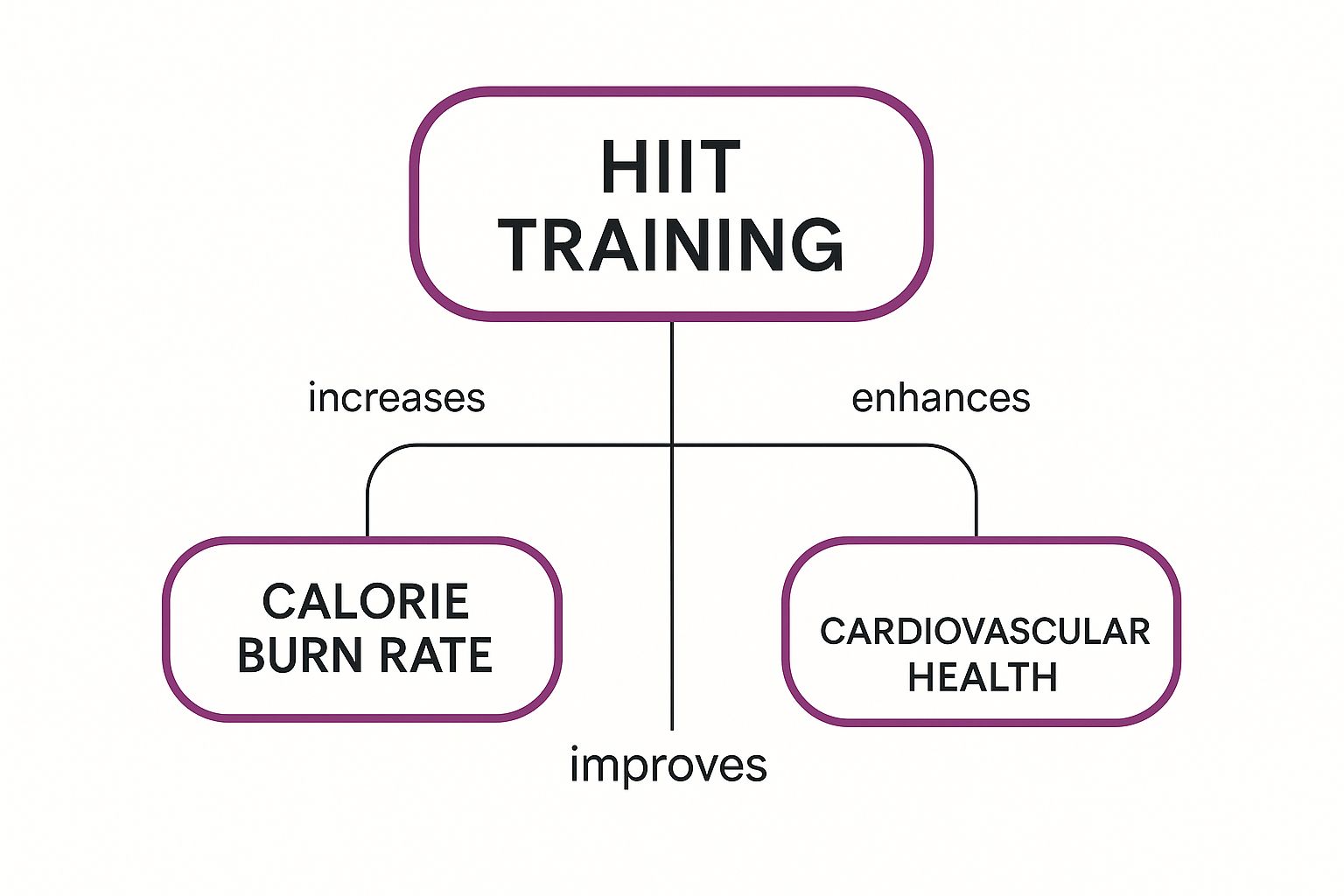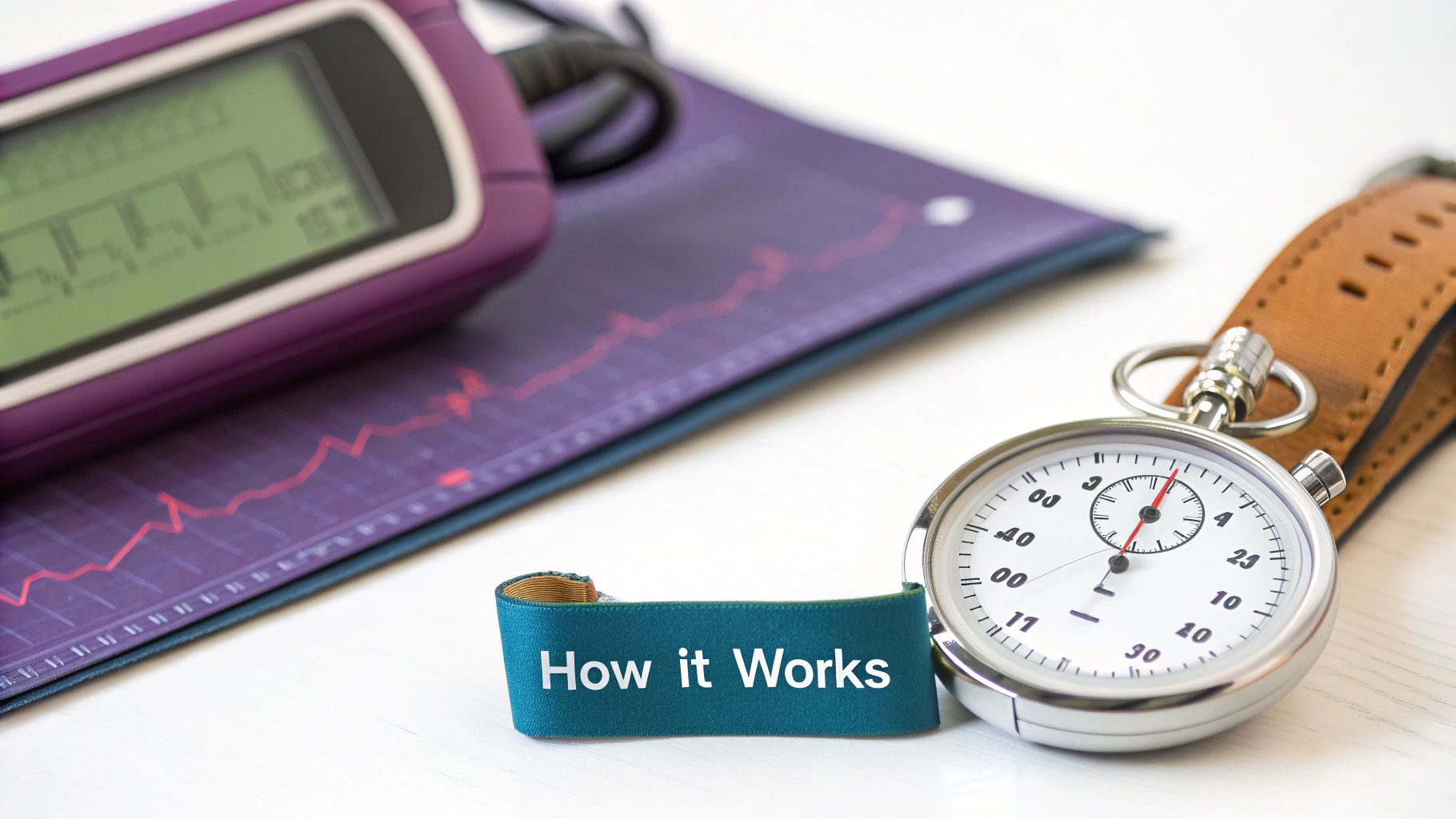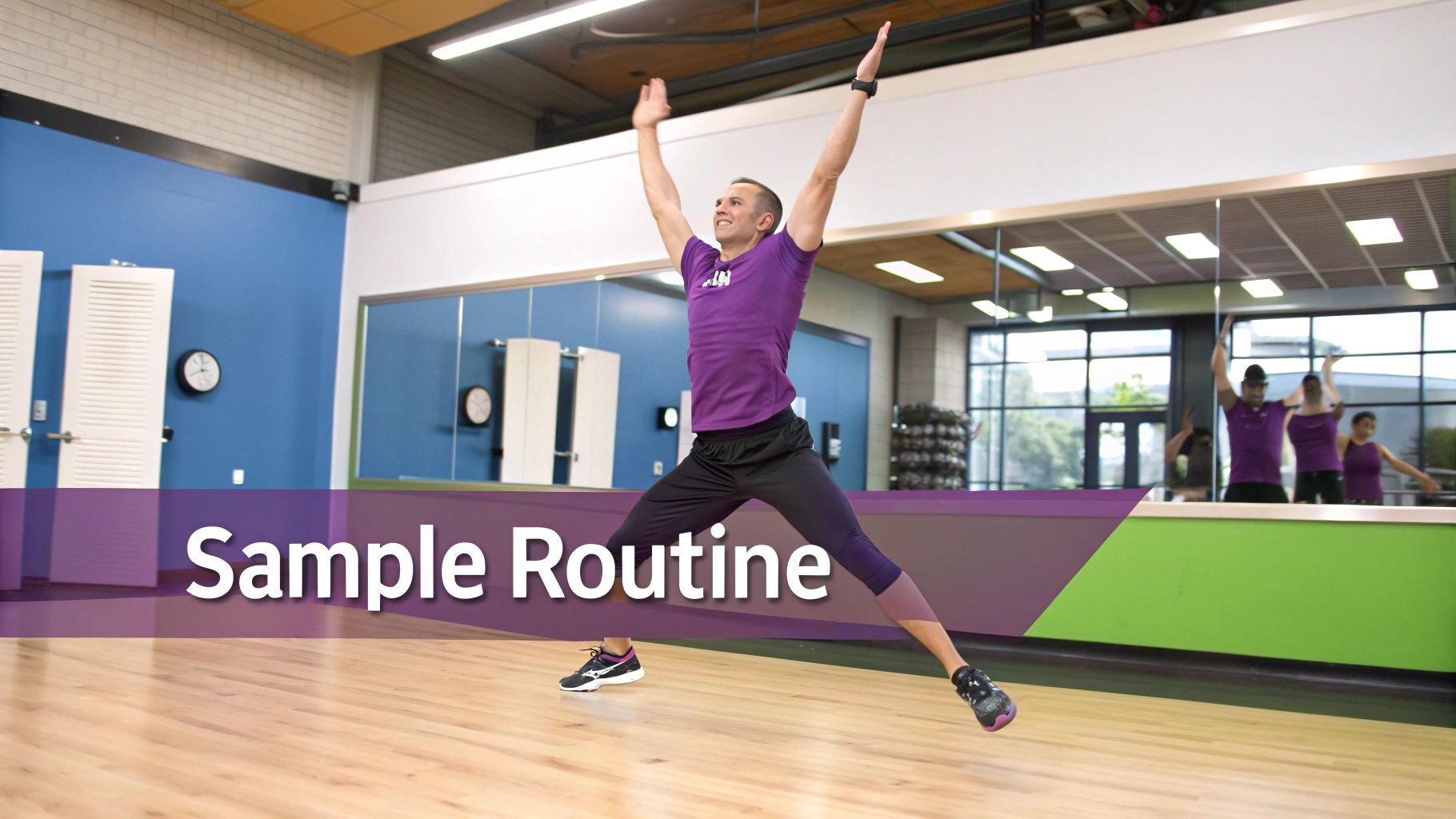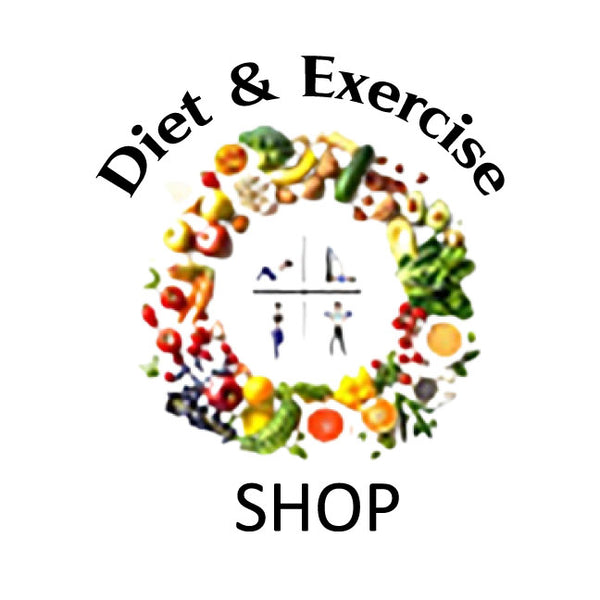
What Is HIIT Training and How Does It Work?
What is HIIT? The acronym stands for High-Intensity Interval Training. It's a workout style focused on giving maximum effort for short periods, followed by brief moments of rest.
Forget long, steady jogs. HIIT is like a series of all-out sprints instead of a marathon. The formula is simple but incredibly effective: go hard, recover, and then repeat. This method is perfect for getting results without spending hours at the gym.
The Work-Rest-Repeat Formula
At its core, HIIT is built on a powerful cycle. You push your body to its peak for a short burst, usually 20 to 60 seconds. Then, you pull back for a recovery period just long enough to catch your breath before you go again.
This constant push-and-pull keeps your heart rate soaring. It challenges your body in a way that steady, moderate exercise just can't match. The real magic happens in that fluctuation between max effort and active recovery.

This structure makes HIIT unbelievably efficient. You can get a killer workout and see real fitness gains in sessions as short as 15-20 minutes. To get started with a simple and effective HIIT tool, our Premium Jump Rope is a fantastic choice. It's portable, easy to use, and perfect for the quick, intense bursts HIIT requires.
More Than Just a Time-Saver
The power of HIIT goes beyond just fitting a workout into a busy schedule. The results are impressive, especially compared to traditional, moderate-intensity exercise.
For instance, studies consistently show that HIIT can improve cardiovascular fitness by up to 25% in just a few weeks. In contrast, you might only see a 10-15% improvement with steady-state cardio over the same period. For more on fitness trends, the American College of Sports Medicine offers great insights on their ACSM Fitness Trends page.
HIIT is a game-changer because it teaches your body to recover quickly from stress. This improved recovery capability translates not only to better workouts but also to handling daily stressors more effectively.
This potent combination of intense exercise and smart recovery is a fast track to hitting your fitness goals.
HIIT vs Traditional Cardio at a Glance
| Feature | HIIT (High-Intensity Interval Training) | Traditional Cardio (Steady-State) |
|---|---|---|
| Duration | Short (10-30 minutes) | Longer (30-60+ minutes) |
| Intensity | Very High (80-95% max heart rate) | Moderate (60-75% max heart rate) |
| Structure | Bursts of max effort + recovery periods | Continuous, steady pace |
| Primary Goal | Maximize calorie burn & metabolic rate | Build endurance & aerobic base |
| Afterburn (EPOC) | Significant; burns calories for hours post-workout | Minimal; calorie burn stops shortly after |
| Best For | Time-crunched individuals, fat loss, metabolic conditioning | Endurance athletes, recovery days, beginners |
This table shows that while both methods have their place, they serve very different purposes. HIIT is about maximizing impact in minimal time, while traditional cardio is a marathon, not a sprint. To enhance your HIIT workouts, especially those involving strength, an Adjustable Dumbbell Set allows for quick weight changes, perfect for fast-paced circuits.
The Science Behind the Afterburn Effect
The real magic of HIIT isn't just the calories you burn during the workout; it's what your body keeps doing for hours after. This is thanks to a process called Excess Post-exercise Oxygen Consumption, or EPOC. Most of us just call it the "afterburn effect."
When you push your body into those all-out intervals, you create an "oxygen debt." Your muscles demand more oxygen than your heart and lungs can supply. This triggers major metabolic changes.
Once you finish, your body works to repay that debt. It restores oxygen levels, clears out lactic acid, and repairs muscle tissue. All these jobs require energy, meaning your body torches calories at a higher rate long after you've hit the showers.
What Is an Oxygen Debt?
Ever sprinted to catch a bus? For that brief, explosive effort, you burn energy faster than you can breathe in oxygen. When you stop, you're left gasping for air. That's your body working overtime to replenish oxygen—a perfect example of EPOC.
During HIIT, you create that "sprint for the bus" effect over and over. This cycle revs up your metabolism in a way a steady jog can't. The payoff is a prolonged calorie burn that can last for up to 24 hours post-workout.
HIIT essentially turns your body into a more efficient calorie-burning machine, even while you're resting on the couch. The afterburn effect means your workout is still delivering results long after you've finished.
This graphic breaks down how this intense training style delivers its core benefits, from fat loss to heart health.

As you can see, the high-intensity nature of HIIT is the engine behind its biggest advantages.
Boosting Your Cardiovascular Fitness
This process does more than just melt fat. It places a healthy demand on your heart, forcing it to adapt by becoming stronger and more efficient. A key measure of cardiovascular fitness is VO2 max, the maximum amount of oxygen your body can use during intense exercise.
Studies show HIIT is one of the best ways to improve VO2 max. By regularly pushing your heart to work near its peak capacity, you’re training it to pump more oxygen-rich blood with every beat. This is a cornerstone of long-term heart health.
To recover from this intensity, you need the right tools. A Foam Roller for Muscle Recovery is fantastic for soothing sore muscles and improving flexibility. Combining smart training with even smarter recovery is the secret to lasting results.
Why HIIT Is a Smarter Way to Train
HIIT isn't just a workout fad. It’s a smart training strategy that delivers serious results without consuming your time. The benefits are real and perfect for juggling a busy life with fitness goals.

This incredible efficiency is a huge part of its popularity. HIIT has consistently been a top global fitness trend. Surveys from the American College of Sports Medicine show HIIT has stayed in the top 10 since 2018. If you're curious, you can learn what is popular in fitness worldwide and see for yourself.
Get More Done in Less Time
This is the biggest draw for most of us. Why spend an hour on a treadmill when you can get better results in just 15-20 minutes?
This is about working smarter, not longer. By pushing your body to its max for short periods, you spark a bigger physiological reaction. Your body is forced to adapt, making you stronger and fitter in a fraction of the time.
Build a Stronger, Healthier Heart
Think of HIIT as a high-powered training camp for your heart. Those intense intervals make your heart work harder and pump blood more efficiently, which strengthens the heart muscle.
This training has been proven to dramatically improve your VO2 max—the gold standard for aerobic fitness. A higher VO2 max means your body gets better at using oxygen, giving you more stamina for everything you do.
"Your heart is a muscle, and HIIT is the ultimate personal trainer for it. Pushing it to its peak and then letting it recover makes it stronger and more resilient."
— DietExercise Channel Fitness Expert
Build and Maintain Lean Muscle
It’s a myth that cardio kills muscle gains. HIIT flips that idea on its head. The explosive exercises activate your fast-twitch muscle fibers—responsible for strength, power, and size. Research shows HIIT can increase fat-free mass by 1% to 3%.
To boost muscle-building, add resistance. Weaving weights into your HIIT circuits creates a bigger challenge. An Adjustable Dumbbell Set is perfect for this, as you can quickly change the weight to match the exercise. This two-for-one benefit of torching fat while sculpting muscle truly makes HIIT a smarter way to train.
Three HIIT Workouts You Can Do Today
Knowing the theory is great, but the magic happens when you put it into practice. HIIT is incredibly versatile—you don't need a fancy gym or expensive gear to get a phenomenal workout.
Here are three routines for different fitness levels.
Always warm up for 5 minutes with light cardio and dynamic stretches, and never skip the cool-down. For floor exercises, a good mat makes all the difference. The Non-Slip Yoga & Exercise Mat provides cushioning and grip, so you can focus on your form.
Beginner Bodyweight HIIT Circuit
If you're just starting, your body is the best tool. This workout builds strength and endurance without hammering your joints. The goal is to learn the movements and push your limits safely.
Follow this simple table. Go all-out during the "Work" interval, then catch your breath during the "Rest" interval.
Beginner Bodyweight HIIT Circuit
| Exercise | Work Interval | Rest Interval | Rounds |
|---|---|---|---|
| Jumping Jacks | 30 seconds | 30 seconds | 4 |
| Bodyweight Squats | 30 seconds | 30 seconds | 4 |
| Push-ups (on knees) | 30 seconds | 30 seconds | 4 |
| High Knees | 30 seconds | 30 seconds | 4 |
After all four exercises, that's one round. Recover for 60 seconds, then start the next round. This workout takes just 15 minutes. As you get stronger, try reducing your rest time.
Intermediate Dumbbell Challenge
Ready to level up? Adding light or moderate dumbbells provides resistance, which is key for building muscle and boosting the afterburn effect. This routine mixes strength and cardio.
Work for 40 seconds and take a short 20-second rest.
- Dumbbell Thrusters: A squat-to-overhead press that works your entire body.
- Renegade Rows: Plank with hands on dumbbells, rowing one arm at a time. This builds core stability.
- Burpees: The classic full-body punisher. Add a push-up for an extra challenge.
- Alternating Lunges with Dumbbells: Step forward, keeping your core braced.
After all four moves, rest for 60 seconds. Repeat for 4 rounds. This workout takes about 20 minutes. Find more starting points in our guide on workout routines for beginners at home.
Advanced Athlete Burnout
This one is not for the faint of heart. It uses a Tabata-style protocol: 20 seconds of max effort followed by just 10 seconds of rest. This is one of the most effective ways to improve aerobic and anaerobic fitness.
The Tabata protocol is designed to push you to your absolute limit in a very short amount of time. The intensity is brutal, but the results in cardiovascular improvement and calorie burn are unmatched.
Do 8 rounds of one exercise before moving to the next.
- Kettlebell Swings: An explosive hip hinge for power in your glutes and hamstrings.
- Box Jumps: Jump with everything you've got onto a sturdy box, landing softly.
- Battle Ropes (Alternating Waves): A killer for your upper body and core.
- Sprint in Place: Go as fast as humanly possible.
This is an incredibly demanding routine. Form is everything—never sacrifice good technique for speed. The full workout takes about 20 minutes.
Fueling Your Body to Maximize HIIT Results
Putting your body through HIIT is like asking a race car to win a Grand Prix—it won't perform well without the right fuel. What you eat before and after is just as critical as the workout itself.
Proper nutrition gives you the energy to go hard and the materials to recover and build back stronger. Think of your pre-workout snack as high-octane fuel. Your body needs energy it can access fast. This is where simple, easily digestible carbohydrates are your best friend.

This focus on efficiency is why HIIT has exploded in popularity. The global HIIT market was recently valued at around USD 9.89 billion and is projected to hit USD 14.62 billion. That growth is driven by people looking for results without demanding hours at the gym. If you're interested, you can read the full research about the HIIT market.
Simple Pre-Workout Fueling
Getting pre-workout nutrition right doesn't need to be complicated. Aim for a small, carb-focused snack about 30 to 60 minutes before you start.
Here are a few great options:
- A small banana
- A handful of dates or raisins
- A slice of toast with a thin spread of jam
These give you a quick jolt of energy without sitting heavy in your stomach.
Post-Workout Recovery and Repair
After you've crushed your workout, recovery begins. This is your prime opportunity to restock energy and give your muscles the nutrients they need to repair and grow.
The perfect post-workout meal combines protein and carbohydrates. Carbs replenish muscle glycogen, while protein provides the amino acids for muscle repair.
Think of your post-workout meal as a direct investment in your next workout. Refueling properly means less soreness, faster recovery, and showing up even stronger next time.
A protein shake is one of the quickest and most effective ways to kickstart recovery. It gets high-quality protein and carbs to your muscles almost immediately. To make this process seamless, our Premium Protein Powders and Healthy Snacks at DietExerciseShop are formulated to support this recovery window. They offer a convenient and tasty way to make sure your body gets exactly what it needs.
Common HIIT Mistakes and How to Stay Injury-Free
HIIT gets results, but the intensity is a double-edged sword. If you don't approach it smartly, you risk burnout or injury. Let's cover how to train hard and stay healthy.
One of the most common errors is skipping the warm-up and cool-down. These are non-negotiable. A 5-minute warm-up with dynamic movements prepares your body. The cool-down is just as vital for bringing your heart rate down safely and starting the recovery process.
Prioritizing Form Over Speed
When the timer is counting down, it's tempting to rush. But sacrificing form to beat the clock is a fast track to getting hurt. Poor form makes an exercise less effective and stresses your joints.
Always focus on doing each movement correctly. Nail the technique first. Once that's solid, the speed and intensity will follow safely.
The Dangers of Overtraining
HIIT feels so productive that it's easy to fall into the "more is better" trap. Your body needs time to repair and adapt after these tough sessions.
Overtraining is the fastest way to kill your progress. Listening to your body and building in real rest is just as crucial as the workout itself.
Aim for 2-3 HIIT sessions per week on non-consecutive days. This gives your muscles time to rebuild stronger. Watch for signs of overtraining, like constant fatigue, dipping performance, or soreness that won't quit.
Proper recovery is where the magic happens. Tools like a Foam Roller for Muscle Recovery can do wonders for soothing sore muscles and boosting flexibility. You can dive deeper into this topic in our guide on how to recover faster.
Common Questions About HIIT Answered
Jumping into HIIT always brings up a few questions. Let's clear up some of the most common ones so you can start with confidence.
How Many Times a Week Should I Do HIIT?
For most people, 2-3 times per week is the magic number. This workout is intense, and your body needs time to recover. Rest days are part of the program—that’s when your muscles actually repair and get stronger. Trying to do HIIT every day is a fast track to burnout and injury.
Can I Build Muscle with HIIT Alone?
HIIT is brilliant for maintaining muscle and can even help you build some. But if your main goal is significant muscle growth, HIIT alone isn't enough. It's not a replacement for dedicated strength training. The ultimate combo is mixing 2-3 HIIT sessions with 2-3 days of lifting weights. For this, an Adjustable Dumbbell Set is the perfect home gym tool.
Is HIIT Good for Absolute Beginners?
Yes, one hundred percent. The beauty of HIIT is that "high intensity" is relative to your own fitness level. A beginner's high intensity will look very different from an elite athlete's, and that’s how it should be.
If you're new, stick to simple bodyweight moves and focus on form. A good starting work-to-rest ratio is 1:2. For example, go all-out for 20 seconds, then rest for 40 seconds.
What Should I Eat Before a HIIT Workout?
What you eat beforehand can make or break your workout. Have a small, easily digestible carb-heavy snack about 30-60 minutes before you start. This gives your muscles the quick fuel they need. A small banana or a couple of dates are perfect.
To support your fitness journey, from pre-workout fuel to post-workout recovery, DietExerciseShop offers a range of products designed to help you achieve your goals. Explore our collection of exercise equipment and healthy snacks at https://dietexerciseshop.com.
